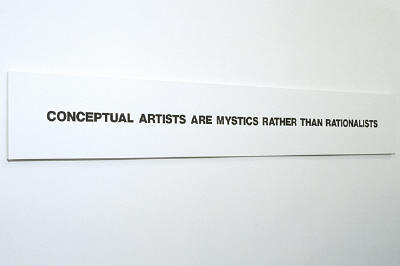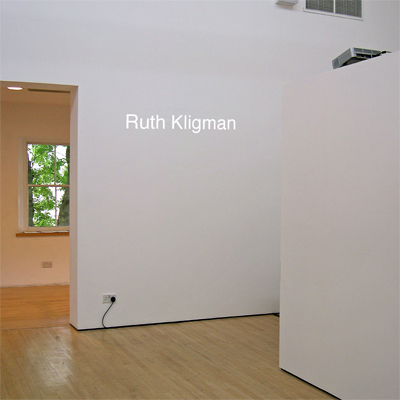 |
|||
| home | features | exhibitions | interviews | profiles | gazetteer | links | archive | forum | |||
|
Ian Whittlesea on YBA, Transition 6 and Rothko's visit to Cornwall
Ian, could we start by saying a bit about you and your work for those that are not familiar with it. In terms of the timing of things you were in London at art school in the early nineties - firstly Chelsea and then the Royal College. Is that right? What was happening at the time? I would guess that the YBA thing was in full swing and indeed you would have been a contemporary of a number of the artists most likely to be associated with this - at times - unfortunate moniker. Can you expand on this? Thatís right I guess Ė although at the time it never felt like I was in the swing of anything, and looking back I think I rather puritanically disapproved of the YBAís ostentatious success, and their desire for it. I studied painting at Chelsea in the late 80ís and then sculpture at the Royal College in the early nineties. At Chelsea I was there at the same time as Chris Offili, Graham Gussin, Franko B and Peter Doig. I remember walking out in the middle of a slide lecture by Doig thinking that it was a totally nostalgic use of figuration that would never interest anyone Ė just shows how much I know. I met Martin Creed at this time, who was studying at the Slade - we were both taught by Roger Ackling.
At the Royal
College Gavin Turk was there and the Chapmans, Tania Kovats and Bethan
Huws had just graduated. Probably the most YBA thing I was involved with
was a series of shows organized by the
After leaving the Royal College you started making text-paintings that are visually minimal and austere, but which in terms of content are complex distillations of cultural history and biography. For example the 'Studio paintings' are paintings in which the different studios of a well-known artist or writer are listed (James Joyce: picture below right). Then there are series like 'Circumnavigation' (studio view: picture above): bearing the names of all the places that Charles Darwin visited in the Beagle. Were any of these works made for specific locations - eg as part of a residency? When you exhibit them do they have to be shown as a complete collection? At the time I finished at the RCA I was still making installations, related to the light in the space they were made for, almost always site-specific. Often they involved projections, or spaces illuminated by the light from TV monitors. They were influenced by Robert Barry, Robert Irwin and James Turrell and their west-coast minimalism. I carried on making these until 1993 or so, and then lost faith in the whole idea of making site-specific things.
I stopped making
anything at all for a couple of years, and had a think. When I was able to
work again I found myself, in 95, making paintings, and using text. I had
a little catalogue that showed how On Kawara made his date paintings, and
I used that as a guide. It seemed that the simplest way to change ones
perception of a space was to put some words in it. Since then Iíve made a large group of single paintings collectively called Studio Paintings, which show the address at which an artist or writer worked. They both evoke the space referred to and suggest that perhaps the room they are in could also be somewhere to work. A piece I always have in mind is Robert Barryís text piece that says: "A place to which we can come, and for a while, be free to think about what we are going to do." (Marcuse) The single paintings lead on to a group of larger ones such as the Circumnavigation painting you mentioned which list locations or destinations. These were consciously more related to ideas of exile Ė the exile or journey of the participant (James Joyce, Darwin, Cťzanne) and the exile of the artist in the studio, the paradox that to think about the world one sometimes has to withdraw from it. Mostly this came about because the paintings were taking longer and longer to make, so I was spending more and more time alone in the studio. The Joyce painting took 3 years, and the Cezanne and Darwin ones much the same amount of time. During this period I was involved with setting up independent studios Ė first Derbyshire Street Arts in East London (with Fiona Banner, Simon Patterson, Bridget Smith, Rowena Dring, Monika Oeschler, Jason Brooks, Bob & Roberta Smith, Donald Parsnips, Matthew Collings and others) and then Occupation Studios in South London. As for showing the work, I began by insisting that there could only be one painting in a room at a time. Mostly I stick to that, but itís also good to mix things up sometimes.
Is this what you would have shown in the important 'Life/Live' show in the Musťe díArt Moderne de la Ville de Paris? This show was - I think - a year before 'Sensation' and in many ways a similar if broader show of young British artists. Is this a fair description?
I showed a single Studio Painting with the Cairn Gallery , who Iíve been working with since 1990. Itís a space run by the Scottish poet Thomas A Clark and the artist Laurie Clark. It was originally in a village in Gloucestershire and has now moved to an even smaller village, Pittenweem, in Fife, Scotland.
One of my favourites is a 'Statement painting' bearing a statement attributed to Sol Lewitt: 'Conceptual artists are mystics rather than rationalists' (picture below). Do you agree with this sentiment? I do think that people who don't get conceptual art think of it as rather dry and intellectual - in a bad way. I guess that historically it often is dry and intellectual in a bad way (Iím thinking of Art & Language and Joseph Kosuth here), but can also be lyrical, moving, amusing or mystical (Robert Barry, Lawrence Weiner, Bethan Huws, Cerith Wyn Evans). Trouble is that unless one has the time and inclination to look and think about it then it may all look like words on a wall in an empty room. More recently youíve been making the 'Everyone projections' in which everyone someone has ever met in their life is listed and their names projected one after the other (including works related to Gertrude Stein, Frank OíHara and Peggy Guggenheim). These lists tend to be very long, and yet there is always a nagging sense that they are incomplete lists. As a viewer I found myself wondering about the people that are left off them - the people who are written out of history. What are the other differences between the paintings and the text pieces as you see them? Itís interesting that you worry about the people left out of the lists. One of the reasons for beginning them was to try and include those normally excluded. So, while the lists are always in progress and can never be complete, I make an effort to find the names of those who arenít famous. Of course the paradox is that they are often only remembered for their relationship to the central, famous, person. In the list that relates to Gertrude Stein for example there are the names of her cleaners, housekeepers and janitors over the years as well as lots of the American soldiers she befriended during the war. Hopefully the form of their presentation is also non-hierarchical Ė each name fades slowly up from black, pauses for a moment, and fades down to black, followed by the next and so on. Each name is given exactly the same emphasis as all the others. Like the paintings they act as a memorial, a moment of reverence for another person or another space. Unlike the paintings I can constantly update them and because they are projected (in daylight) I can easily adjust the scale to suit the space. Itís a pleasure making something that canít be damaged as well. The surface of the paintings is very fragile, so to be able to make a work that doesnít need packing or crating or special handling is a pleasure. Of course, as soon as you make something that relies on electricity then it will inevitably break down, so the problems of the object are always with us.
My wife, Katrine Herian, grew up in Cornwall and went to school in Truro. Her parents still live near Hayle, so we are often in Cornwall visiting them. I also spent a lot of time in Cornwall when I was young. Our next-door neighbors in London sold up and bought a guesthouse overlooking the graveyard above the Tate in St Ives Ė of course the Tate wasnít there then. We only ever visited in the off-season though, so I tended to think of Cornwall as cold, wet and empty. I spent a lot of time in the arcade in St Ives and in the rain at the model village at Lelant. The work for Transition 6 at Newlyn came out of the reading I was doing for Everyone Ė Peggy Guggenheim. Most of the research for these works involves reading biographies, not just of the main protagonist, but also of others in their circle and then plotting lists of names and relationships. I was reading about Rothkoís trip to England in 1959 and remembered seeing a photograph of him having tea with some Cornish artists. It took me a while to track down the photograph, but I found that the Tate had done a small show about Rothko in Cornwall, in 1996. The show caused a bit of a fuss at the time and the booklet, with text by Chris Stephens, which accompanied it, is difficult to get hold of. I think it was felt that the show insulted all the Cornish artists by implying that they were simply making provincial New York School paintings, and that having Rothko to tea should have been the highlight of their lives. Of course itís often argued that the situation was in fact reversed and that Cornish art was more Ďadvancedí and radical than American painting, especially during the 60ís. Iím simplifying a little there - for the real thing one has to read Patrick Heronís articles of the 1970ís about the relationship between British and American art. I was more interested in the narrative possibilities of the photograph (which shows Rothko with his wife Mell taking tea in the garden of Paul and June Feiler, along with the Feilerís children, Peter Lanyon, Marie Miles and Terry Frost) and it lead me to make Everyone - Mark Rothko, which was shown in the upstairs space at Newlyn.
Rothko was only
in Cornwall for 3 days, staying with Lanyon. On his first night he visited
the Gurnardís There is an interesting anecdote in the booklet by Chris Stephens about Rothko going to look at the disused Methodist Chapel outside Lelant with the idea of buying it as a space to show his paintings - it goes on to quote Rothko as saying: ďIt would be good if little places could be set up all over the country, like a little country chapel, where the traveller or wanderer, could come for an hour to meditate on a single paintingÖĒ I presume that it was the chapel on the Lelant to St Ives road that he went to see. When I went past on the bus last summer it still looked fairly rundown and empty. I was lucky enough to meet Helen Feiler when I was making the show, who features in the photograph, and who makes jewelry in Newlyn. Finally, I think the piece returns us to the point you brought up about who is remembered and why - in his 3 days in Cornwall Rothko would have met scores of people in pubs and at the parties arranged for him - we only remember a few of them.
More of Ianís work can be seen at http://www.ianwhittlesea.net http://www.cairneditions.co.uk |
|||
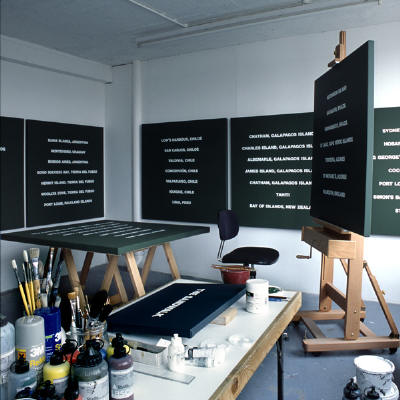
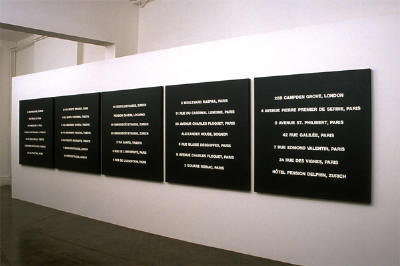
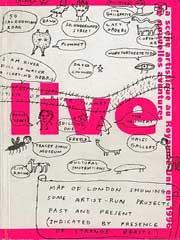 The
Life/Live show in 1996 was one of the first curated by Hans Ulrich Obrist,
and in retrospect seems like the start of his plan to make the
curator/institution more important than the artist. It was a survey show
of independent spaces and galleries from around the UK Ė there is an
excellent two-volume catalogue which gives good idea of what was going on
at the time
The
Life/Live show in 1996 was one of the first curated by Hans Ulrich Obrist,
and in retrospect seems like the start of his plan to make the
curator/institution more important than the artist. It was a survey show
of independent spaces and galleries from around the UK Ė there is an
excellent two-volume catalogue which gives good idea of what was going on
at the time